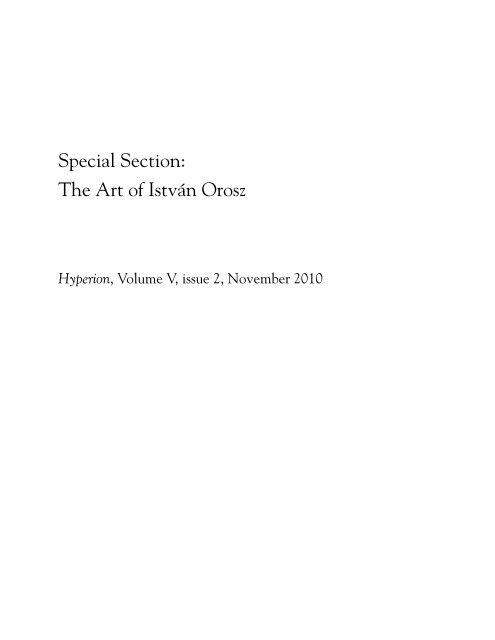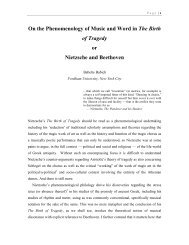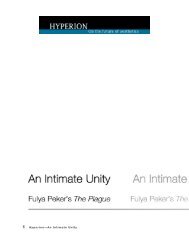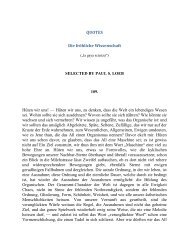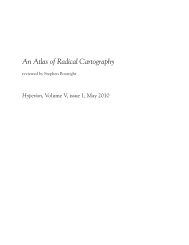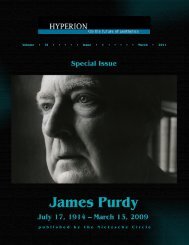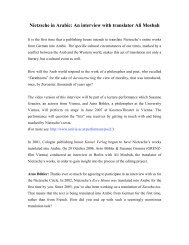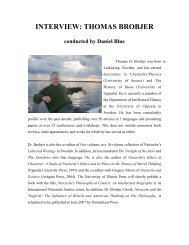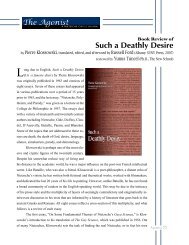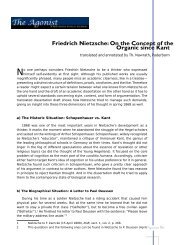Special Section: The Art of István Orosz - Nietzsche Circle
Special Section: The Art of István Orosz - Nietzsche Circle
Special Section: The Art of István Orosz - Nietzsche Circle
Create successful ePaper yourself
Turn your PDF publications into a flip-book with our unique Google optimized e-Paper software.
<strong>Special</strong> <strong>Section</strong>:<br />
<strong>The</strong> <strong>Art</strong> <strong>of</strong> <strong>István</strong> <strong>Orosz</strong><br />
Hyperion, Volume V, issue 2, November 2010
11 Hyperion—<strong>The</strong> <strong>Art</strong> <strong>of</strong> <strong>István</strong> <strong>Orosz</strong>
<strong>Special</strong> <strong>Section</strong>:<br />
<strong>The</strong> <strong>Art</strong> <strong>of</strong> <strong>István</strong> <strong>Orosz</strong><br />
edited by Kristóf Fenyvesi<br />
and the editors <strong>of</strong> Hyperion<br />
Introduction: <strong>István</strong> <strong>Orosz</strong><br />
Changing the Geometry <strong>of</strong> Thought<br />
by Mark Daniel Cohen<br />
“<br />
I was just going to say, when I was interrupted,<br />
that one <strong>of</strong> the many ways <strong>of</strong> classifying<br />
minds is under the heads <strong>of</strong> arithmetical and<br />
algebraical intellects. All economical and<br />
practical wisdom is an extension or variation<br />
<strong>of</strong> the following arithmetical formula: 2+2=4.<br />
Every philosophical proposition has the more<br />
general character <strong>of</strong> the expression a+b=c. We<br />
are mere operatives, empirics, and egotists,<br />
until we learn to think in letters instead <strong>of</strong><br />
figures.<br />
<strong>The</strong>y all stared.<br />
—Oliver Wendell Holmes<br />
If the purpose <strong>of</strong> art is to punish its palms against the doors<br />
<strong>of</strong> perception, then a rail is wanted to channel, past every<br />
possibility <strong>of</strong> ingress, to corridor the revelation around the<br />
faults <strong>of</strong> nothing more than madness, to guide it down the<br />
braiding line to something <strong>of</strong> the truth. It is not an inclination<br />
towards rationality over feelings, for reason can wind as<br />
Hyperion—Volume V, issue 2, November 2010 12
feverish and frenzied as the more familiar, no more frequent<br />
rages <strong>of</strong> affection. It is rather a rigor for the mind, a necessary<br />
discipline to deter us in our urge to the insanity <strong>of</strong> unending<br />
self-delusion, to patronize ourselves, to pander every thought<br />
to our constant desire for blandishment and commiseration,<br />
and to head the intellect, untrusting <strong>of</strong> the ballast <strong>of</strong> common<br />
observation, around the drop zones <strong>of</strong> nothing but psychology.<br />
<strong>The</strong> so-far perennial, far-too-unquenchable religious impulse<br />
aside, it is a peculiarity and distinguishing feature <strong>of</strong> the<br />
modern world that we expect <strong>of</strong> art a penetration into realms<br />
otherwise beyond our reach. We expect the sublime, which,<br />
regardless <strong>of</strong> the variety <strong>of</strong> meanings to the concept prior<br />
to our age, has come to signify a parting <strong>of</strong> the veils. <strong>Art</strong> as<br />
the royal road to truth, even if the truth <strong>of</strong> the matter is that<br />
there is none, an equivocation that remains unequivocally<br />
an answer. But which veils?—the seemingly vaporous things<br />
become difficult to distinguish among, and the relentlessly<br />
infantile impulse to talk about ourselves turns out to be the<br />
never so subtle or sublime subtext in everything we think.<br />
Our most personal and frequently most trivial concerns—our<br />
passions, apathies, and anxieties—make up the template<br />
by which we understand everything our minds address. As<br />
observed in the texts by <strong>István</strong> <strong>Orosz</strong>, whose art and writings<br />
these notes serve to introduce, “Man originally entered into<br />
the world in such a way that he would see himself in things.<br />
He is incapable <strong>of</strong> seeing, feeling or comprehending anything<br />
as independent <strong>of</strong> himself. He can only correlate every<br />
experience with himself.”<br />
<strong>The</strong> credible objective is not to forestall our self-absorbed<br />
disclosures, but to manage to concern ourselves with<br />
something more at the same time as we continue to babble<br />
about the something less—to make our claimed concern into<br />
the subtext. That difficult piece <strong>of</strong> intellectual acrobatics—to<br />
move our minds outside ourselves—has been a periodic<br />
enterprise <strong>of</strong> advanced thought, amounting to the initiation<br />
<strong>of</strong> science. We find it first in the Ionian school, particularly<br />
on the part <strong>of</strong> Aristarchus, the first proponent we know <strong>of</strong><br />
Heliocentrism, an idea out <strong>of</strong> favor if not mind for nearly<br />
two millennia, according to Stephen Hawking and Leonard<br />
Mlodinow, until Copernicus and Galileo acquired it again.<br />
<strong>The</strong> issue at hand has not been merely the center <strong>of</strong> the<br />
solar system but the center <strong>of</strong> the universe—that is to say,<br />
13 Hyperion—<strong>The</strong> <strong>Art</strong> <strong>of</strong> <strong>István</strong> <strong>Orosz</strong>
ultimately whether humanity is at the center <strong>of</strong> the universe,<br />
and, (in an ultra-modern turn <strong>of</strong> thought) more ultimately,<br />
whether mind is at the center <strong>of</strong> the universe. <strong>The</strong> matter at<br />
issue is whether we can escape the perspectivally imposed<br />
illusion that the universe is arranged in an expanding sphere<br />
<strong>of</strong> perception with us at its core—an impossibility on the face<br />
<strong>of</strong> it and which impels the problem <strong>of</strong> “<strong>The</strong> Other”—whether<br />
the universe must be set in a stretching sphere <strong>of</strong> perception<br />
around each <strong>of</strong> us, regardless <strong>of</strong> the incorrigible appearance<br />
<strong>of</strong> things.<br />
<strong>The</strong> heart <strong>of</strong> the thought, and thus the heart <strong>of</strong> the scientific<br />
view, is that the truth <strong>of</strong> things is as they are understood from<br />
the outside, not from within, the truth <strong>of</strong> them is not how they<br />
appear to be unto themselves but how they comport with the<br />
systematics <strong>of</strong> a larger reality—not as they are appreciated,<br />
but as they are conceived. It is as much as to move (as<br />
once we needed to) from the view that physical laws are<br />
comparable to human statutes to the realization that they are<br />
nothing related. (Only one requests obedience; planets do<br />
not choose their orbits.) <strong>The</strong> more direct attempt to escape<br />
from the provinciality <strong>of</strong> our perspective—to elude not merely<br />
the Ptolemaic system but the human-centered viewpoint, the<br />
appearance <strong>of</strong> the world that the positioning and functioning<br />
<strong>of</strong> our sense organs compels it to possess—was conducted<br />
probably first by Helmholtz in his mathematical and scientific<br />
investigation into Kant’s Transcendental Idealism, his attempt<br />
to determine how our sense organs and our minds construct<br />
the space, time, and causal relations we perceive and, from<br />
that, infer what we can say about the raw material they begin<br />
with—what the world is like apart from our perception <strong>of</strong> it.<br />
However, it is more to the point here to look for the beginnings<br />
<strong>of</strong> a true violation <strong>of</strong> the barriers <strong>of</strong> normative human<br />
perception in the expansions <strong>of</strong> geometry—material that<br />
Helmholtz worked with—starting with Gauss earlier in the<br />
nineteenth century. It was thoroughly evident to Helmholtz,<br />
for one, that alternate geometries, such as n-dimensional<br />
geometry and non-Euclidean geometry, would be impossible<br />
to perceive if they were the pattern <strong>of</strong> our world—space must<br />
appear flat to us, not simply because we mentally, or even<br />
physiologically, construct it that way, but because the physics<br />
our perceptual apparatus obey force the illusion. If space were<br />
curved, light would curve with it, and our eyes still would seem<br />
to track the light back along an apparent straight line, as we<br />
Hyperion—Volume V, issue 2, November 2010 14
now know does in fact happen. Objects appear to be, as they<br />
self-evidently must, directly behind the point at which the light<br />
from them hits our eyes, even if the object is somewhere very<br />
else and the light bent with space on its way to us so as to hit<br />
our eyes as it does. Far more simply—light is appearance.<br />
Which can be said to make the point, after a fashion, that was<br />
Kant’s broad stroke with the Transcendental Idealism: that<br />
the formulaics <strong>of</strong> experience and conception are imposed<br />
on us and cannot be said to be <strong>of</strong> the world inherently. <strong>The</strong><br />
world as it is unto itself is impossible to perceive, but what<br />
did not come to Kant was what followed in mathematics—<br />
the movement from measurement and arithmetic to a more<br />
thorough reliance on algebra, on the use <strong>of</strong> variables so as to<br />
make it possible to propose rationally formulations that would<br />
be unvisualizable, beyond perception—to make it possible<br />
to conceive a world so structured as to be impossible to<br />
perceive, to conceive according to pure reliance on formula,<br />
without reliance on or reference to even hypothetical sense<br />
impression, to even the mind’s eye. <strong>The</strong> intellectual trend<br />
was so emphatic that even the autocrat at the breakfast table<br />
could recommend it as a general tonic by mid-century, and<br />
before the end <strong>of</strong> the century, the full flood was approached<br />
in the project to axiomaticize arithmetic, to demonstrate it to<br />
be a logically coherent, internally reliant system that did not<br />
employ observation even for its premises—to demonstrate<br />
mathematics to be a priori analytic and entirely free <strong>of</strong> the<br />
specifics <strong>of</strong> the world <strong>of</strong> experience in its formulation and<br />
its limitations, even as it maps the world <strong>of</strong> experience<br />
and, potentially and with a full draft <strong>of</strong> presumption drawn,<br />
the world as it is beyond experience, beyond common<br />
observation.<br />
And art as well turned towards the possibilities <strong>of</strong> the<br />
revelation by means <strong>of</strong> mathematics, towards what the<br />
world might be like were the geometries <strong>of</strong> more than three<br />
dimensions or <strong>of</strong> curved dimensions the truth <strong>of</strong> things. It is a<br />
seeking <strong>of</strong> ontological insight that is possessed <strong>of</strong> the fresh<br />
air and unimpeded breath <strong>of</strong> self-possessed rationality and<br />
free <strong>of</strong> the dizzying dengue <strong>of</strong> mysticism, and for all the art<br />
infused by the religious impress—the influence <strong>of</strong> theosophy<br />
put a variety <strong>of</strong> stamps on a variety <strong>of</strong> movements around the<br />
turn <strong>of</strong> the century—there is a clear line <strong>of</strong> works impelled,<br />
or at least propelled, by mathematical thought. <strong>The</strong> history <strong>of</strong><br />
them is covered in detail in the excellent book (presently out<br />
15 Hyperion—<strong>The</strong> <strong>Art</strong> <strong>of</strong> <strong>István</strong> <strong>Orosz</strong>
<strong>of</strong> print) <strong>The</strong> Fourth Dimension and Non-Euclidean Geometry<br />
in Modern <strong>Art</strong>, by Linda Dalrymple Henderson.<br />
During that period, there were a large number <strong>of</strong> books on the<br />
subject published in Europe and the United States, some <strong>of</strong><br />
which we continue to read: <strong>The</strong> Time Machine, by H.G. Wells,<br />
and Flatland, by Edwin A. Abbott, for two. It can be argued<br />
as well that several movements in the visual arts, specifically<br />
movements into nonrepresentational abstraction, were<br />
oriented from one angle or another on the idea <strong>of</strong> an altered<br />
geometry <strong>of</strong> reality.<br />
Of course, to employ the means <strong>of</strong> visual art to this purpose<br />
is to take what had been in the ages <strong>of</strong> religious art on the<br />
low simmer <strong>of</strong> a conundrum and bring it to the full boil <strong>of</strong> a<br />
paradox: to attempt to visualize the now demonstrably, as<br />
Helmholtz knew, unvisualizable. Abstraction can be said to<br />
gesture in that direction by mere suggestibility, but if so, it also<br />
can be said to be nothing other than a displaced paradox:<br />
trying to symbolize the innately unsymbolic.<br />
<strong>The</strong> inescapability <strong>of</strong> the paradox—perhaps a redundancy—is<br />
maybe due to the double reversal at its core: thought, which<br />
was rooted in the observable, transformed into pure equations<br />
then to be brought by visual art back into the visualizable, the<br />
experiential—thought transformed from figures into letters<br />
transformed again into figuration. It was the movement into<br />
algebraic thought that opened the possibility <strong>of</strong> advanced<br />
geometric thought, and the attempt to simulate advanced<br />
geometrical experience. Abstract art might be an attempt to<br />
answer: what did the time traveler see?<br />
But more fertile could be, for it would be and is far more<br />
directly engaged, the attack through the art <strong>of</strong> paradox: the<br />
art that renders impossible objects and situations, projective<br />
geometries, visual paradoxes, optical illusions, structural<br />
conundra, reflective anamorphoses, and other forms <strong>of</strong><br />
visualized inexplicabilities.<br />
This is the art tradition to which <strong>István</strong> <strong>Orosz</strong> belongs, and <strong>of</strong><br />
which he is one <strong>of</strong> the leading practitioners.<br />
<strong>Orosz</strong> is a Hungarian artist who works in a wide variety <strong>of</strong><br />
graphic media. He is a painter, printmaker, graphic designer,<br />
illustrator, and designer <strong>of</strong> theater, movie, exhibition, and<br />
political posters. He also works as an animated film director.<br />
Hyperion—Volume V, issue 2, November 2010 16
He is known internationally and primarily as a mathematically<br />
inspired artist, an artist <strong>of</strong> geometric ingenuity, who employs<br />
many forms <strong>of</strong> visual paradox, executed with traditional<br />
printing techniques such as woodcutting and etching, to<br />
produce “impossible objects” and other optical illusions<br />
that present on a flat sheet <strong>of</strong> paper clear two-dimensional<br />
representations <strong>of</strong> three-dimensional objects that could not<br />
possibly exist. One can see that, in “reality,” one could not see<br />
them.<br />
Since 1984, <strong>Orosz</strong> has used the pseudonym “OUTIS,”<br />
which is Greek for “nobody,” and more specifically is the<br />
false name Odysseus took when he tricked Polyphemus,<br />
the Cyclops, and put out the creature’s one eye. <strong>Orosz</strong> has<br />
said that the name refers to “some kind <strong>of</strong> attack upon the<br />
eye.” One might also read it as referring to a shattering <strong>of</strong><br />
the human perspective, a piercing <strong>of</strong> the human projection<br />
upon the visible scene, an act that accomplishes just what<br />
Antigone sought: to remove one’s face from the mirror, so<br />
as to transform a mere reflection into a vision, and, as every<br />
moment <strong>of</strong> destruction is also an initiation—until it’s not—see<br />
what is behind the focus on one’s self.<br />
<strong>Orosz</strong> is part <strong>of</strong> an artistic tradition that is barely identified and<br />
rarely acknowledged and assessed in art history, although<br />
it is widely known and extraordinarily popular. This kind <strong>of</strong><br />
work is comparable in its reputation to a statue everyone has<br />
seen and no one thinks about—a sculpture that prompts the<br />
response, when one is told the name <strong>of</strong> the sculptor, “so that’s<br />
who that is.” <strong>The</strong> touchstone <strong>of</strong> recognition here, the artist who<br />
is the best known <strong>of</strong> <strong>Orosz</strong>’s predecessors, is M. C. Escher.<br />
<strong>The</strong> lineage stretches back farther than that, and the starting<br />
point is a question <strong>of</strong> personal judgment. <strong>The</strong> heritage <strong>Orosz</strong><br />
has taken up includes Arcimboldo, Dali, Magritte, one famous<br />
example by Hogarth, Duchamp’s impossible bed, arguably<br />
the phantasmagoric prisons <strong>of</strong> Piranesi, and more recently,<br />
formulations by mathematicians, such as the Penrose Triangle<br />
created by Roger Penrose, among many others.<br />
It is an obscurely known artistic tradition, but it is an<br />
imperative one, for it is a distinctly intelligent one. As <strong>Orosz</strong><br />
points out in one <strong>of</strong> his texts, this kind <strong>of</strong> artwork has been<br />
a function <strong>of</strong> “serious intellectual speculation.” <strong>Orosz</strong>’s<br />
writings display such a stamp <strong>of</strong> penetrating speculation—<br />
an impressive exercise in sheer thoughtfulness—and he<br />
17 Hyperion—<strong>The</strong> <strong>Art</strong> <strong>of</strong> <strong>István</strong> <strong>Orosz</strong>
discusses the lineage at length.<br />
It is best to let him deal with these concerns himself—they<br />
are his inheritance and he speaks <strong>of</strong> them with the implicit<br />
authority <strong>of</strong> a master, the authority that comes <strong>of</strong> authenticity.<br />
<strong>The</strong> one other matter worth remarking on in these notes is the<br />
point <strong>of</strong> such artistic speculation: the pay-<strong>of</strong>f, the benefit to the<br />
viewer. Why do this?<br />
It has been said that time is the medium <strong>of</strong> thought—one<br />
<strong>of</strong> the few things said about time that makes any sense.<br />
Similarly, geometry is not merely an object <strong>of</strong> thought; it is<br />
also the medium <strong>of</strong> thought. Thought always possesses<br />
a geometry that structures it, that essentially it is. That<br />
geometry is its principle <strong>of</strong> progress, and thought is a dynamic<br />
system, not an inert structure (which is why any theory <strong>of</strong><br />
representation is inherently inadequate for “representing”<br />
thought). <strong>The</strong> geometry inherent in thought is so obvious a<br />
matter, so simple a quality, that, as with all simple things, we<br />
tend to look right past it. But we sometimes acknowledge it<br />
when remarking almost idly—we talk <strong>of</strong> following a “line <strong>of</strong><br />
thought.”<br />
One example, a common one, <strong>of</strong> the geometry <strong>of</strong> thought<br />
and how we simply assume its nature: we take for granted<br />
when making an argument that, with every step <strong>of</strong> thought,<br />
with every point made, we move farther away from our<br />
starting point. A good (well-formulated) argument will get us<br />
“somewhere.” This is specifically a geometric assumption,<br />
and it is not the only one we might employ. Assuming all<br />
forms <strong>of</strong> process lead one farther on, in a specifically distance<br />
metaphor, is comparable to failing to realize that if one flies a<br />
plane due east from New York and stays on course, eventually<br />
one will end up where one began. Sometimes returning<br />
to one’s beginnings, like a destination coming up over the<br />
horizon line, is not the mark <strong>of</strong> an error—sometimes, it is a<br />
closing <strong>of</strong> the circle.<br />
<strong>The</strong> “point” here is that changing the geometry <strong>of</strong> thought is<br />
a prodigious accomplishment, something very rare and very<br />
difficult to describe, and true revolutions <strong>of</strong> thought are rooted<br />
not in the development <strong>of</strong> new ideas but in the devising <strong>of</strong> new<br />
structures for arriving at ideas. This was achieved by Einstein,<br />
specifically in his application <strong>of</strong> the Lorentz transformations,<br />
and by Bohr and Heisenberg in the theoretical foundation <strong>of</strong><br />
Hyperion—Volume V, issue 2, November 2010 18
Quantum Mechanics. It also was done in overt fashion—done<br />
as the overt achievement—by Gödel, giving us a new method<br />
for testing the logical consistency <strong>of</strong> a logical system.<br />
Einstein said that a good question is a question that has<br />
an answer. To develop new ideas is merely to provide new<br />
answers to standing questions. That is no small thing, but it is<br />
not the greatest thing. To change the geometry <strong>of</strong> thought is<br />
to replace old questions, questions that we could not answer,<br />
with new ones, potentially, ideally, with questions that are<br />
answerable. Currently, Hawking and Mlodinow are making<br />
precisely that point with regard to Quantum theory and the<br />
new M-theory that has developed, at least in part, from it.<br />
Questions that were unanswerable, almost beyond phrasing—<br />
such as that regarding the beginning <strong>of</strong> time itself—become<br />
answerable through being changed in their substructure, in<br />
the structure by which the entire matter is approached, by<br />
being thought through in a different way.<br />
<strong>The</strong> works <strong>of</strong> the artistic lineage <strong>Orosz</strong> participates in, the<br />
art <strong>of</strong> geometric ingenuities and impossible objects, can<br />
be considered probings into the limits <strong>of</strong> the imposed, flat,<br />
three-dimensional imaging <strong>of</strong> our perceptions—as can the<br />
best <strong>of</strong> abstract art. Probings are not answers, but they are<br />
far more serious than answers. <strong>The</strong>y are where all serious<br />
thought begins. <strong>The</strong>re is a certain playfulness to thought when<br />
it pursues what is most difficult to chase: something utterly<br />
different in nature and capability. Otherwise, we do nothing<br />
more than rework standard questions and pat answers. This<br />
kind <strong>of</strong> serious playfulness, the kind that <strong>Orosz</strong> practices, is<br />
how we test boundaries, and penetrate them.<br />
<strong>István</strong> <strong>Orosz</strong> has had several exhibitions in the United<br />
States. Even so, and despite his reputation in Europe and<br />
having been the recipient <strong>of</strong> several awards, he is not as well<br />
known here as he should be. Hyperion is proud to have the<br />
opportunity to publish a number <strong>of</strong> his graphic works and<br />
a selection <strong>of</strong> his writings. We also <strong>of</strong>fer several special Ex<br />
Libris bookplate designs that <strong>Orosz</strong> created for Hyperion<br />
readers. <strong>The</strong> Ex Libris bookplates are available here, for free,<br />
as jpg and pdf files that can be downloaded and printed out,<br />
for use in your diminishing quantity <strong>of</strong> finely printed (real)<br />
books. For our readers and ourselves, we thank <strong>István</strong> <strong>Orosz</strong><br />
for his generous gift.<br />
19 Hyperion—<strong>The</strong> <strong>Art</strong> <strong>of</strong> <strong>István</strong> <strong>Orosz</strong>


